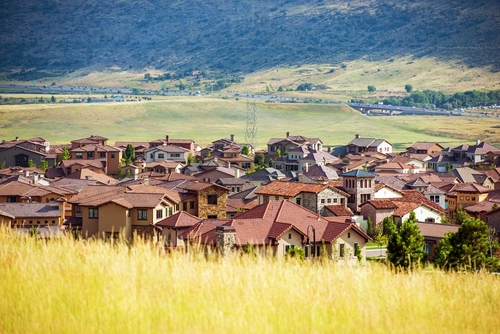Home Insurance Costs going Up In Colorado

Denver Colorad Metro Residential Area – Data from the National Insurance Crime Bureau found that Colorado came in second place behind Texas for the most hail and high winds related insurance claims in 2016.
Over the last few years Colorado residents have seen their insurance rates headed up. According to industry data, rates for homeowners have gone up 67 percent while drivers have seen rates climb 52 percent. Unfortunately, due to three hailstorms that hit the Front Range recently, insurance costs could be going up again.
The recent hailstorms, which caused $500 million in insurance claims, will likely push up rates despite the fact that Colorado residents have seen homeowners and auto insurance rates climb at the third fastest rate in the nation over the last eight years.
Hailstorms Are a Big Factor
While Colorado is no stranger to severe weather, hailstorms have been a constant in the world of insurance claims. A June hailstorm hit Fountain and resulted in 26,000 claims that totaled $169 million in damage. This storm was followed in August by a hailstorm that brought hailstones as big as softballs, triggering 27,000 claims that added up to a whopping $172.8 million. This storm injured 21 people at a local zoo where five animals were killed by the massive hailstorms.
Insurance companies have felt the impact, in Colorado Springs there is a 50-acre parcel of land near the airport that is the current resting spot for roughly 5,000 vehicles that have been totaled by the recent storms. When insurers have to pay out this much in claims, the cost will eventually be passed on to consumers.
Data from the National Insurance Crime Bureau found that Colorado came in second place behind Texas for the most hail and high winds related insurance claims in 2016.
According to a study by QuoteWizard.com that looked at homeowner insurance rates from 2007-2015, the average rate increase in Colorado during these years was 67.4 percent. While Colorado finished third, behind Oklahoma and Kansas, their rate increase was well above the national average increase of 42.7 percent over the same time period.
Colorado saw the biggest rate increases in 2013-2015 when the states average premium skyrocketed at twice the rate of the national average, going from $4.00 above the U.S. average to $210 above that average.
Hail is a major factor in these increases but high winds, floods and wildfires have not helped when it comes to rising insurance rates. This years wildfires will most likely continue to push rates up.
Auto Rates Headed Up as Well
Auto insurance premiums have been headed up as well with the average auto premium rising 52 percent between 2011 and 2017 while the national average increase was only 20 percent. The increase pushed the average auto premium up to $1,435. This puts the Centennial State in the number three slot after Montana and Mississippi when it comes to increasing car insurance costs.
Colorado suffered double digit increases in three of the four years between 2012 and 2015 while the national average for auto premiums was only increase by roughly 2.8 percent.
Population Growth Also a Factor
While hail and other severe weather are absolutely factors in the increase in insurance costs, exploding population centers are also to blame. As once rural land is developed in to suburban neighborhoods, there are many more rooftops and cars that can be damaged by a hailstorm, leading to more and more claims. In addition, the average house size has increased from about 1,700 square feet 25 years ago to 2,500 square feet in 2015, giving the hail a much bigger target to damage.
The same can be said for auto insurance, more people means more cars out on the roads and in parking lots, just waiting to be damaged by a hailstorm or other severe weather incident. Modern cars are also packed with sensors and technology that pushes up the cost of repairs.
Tips For Lowering Your Insurance Costs
If your insurance rates are headed up here are a few tips for keeping your premium affordable:
- Shop Around: This is probably the best tip for lowering your premium costs. Insurers rate risk differently, which can result in dramatically different price quotes. Just make sure you are comparing apples to apples when it comes to coverage levels and deductibles. Easily compare multiple home insurance quotes all in place, we have up to 12 competitive quotes ready for you to review.
- Raise Your Deductible: This is another great way to lower your premium. The higher your deductible, the more affordable your premium. Always choose a deductible that you can easily afford in case you have to make a claim.
- Drop Collision and Comprehensive: If you are driving an older vehicle consider dropping comprehensive and collision but keep the liability coverage. The basic rule of thumb is that if you would replace your current car instead of repairing it after an accident, you no longer need collision and comprehensive coverage.
